Alan M. Petrillo
The Fort Walton Beach (FL) Fire Department runs more than 3,300 calls for service annually, covering a nine-square-mile city and providing automatic aid to eight surrounding stations and mutual aid on call in a three-county area. When it came time to replace its aerial ladder, the department decided it needed a vehicle that could carry all the equipment and more than its then-current aerial vehicle did to increase the rig’s efficiency of use.
Multifaceted Unit
Chief Ken Perkins says the department’s aerial serves in multiple roles, not only as an aerial ladder but often as a pumper and sometimes as a rescue vehicle. “We were replacing a 1996 Pierce 75-foot aerial ladder with a 1,500-gpm pump and 300-gallon water tank that had given us good service,” Perkins says. “Because we ask our aerial to do so much, I put together a committee of firefighters, officers, and chiefs to come up with a plan of exactly what we wanted our new aerial to do.
That process took nine months of planning, investigating, talking with vendors, and examining the different types of aerial apparatus that are available, Perkins points out. “In our municipal government, everything has to go out to bid, so we put together our specs and went to bid, receiving two,” Perkins says. “We have had experience with both manufacturers, and both of them have quality products. Both met the specs, but E-ONE gave us the better price, so we bought the E-ONE eMAX.”
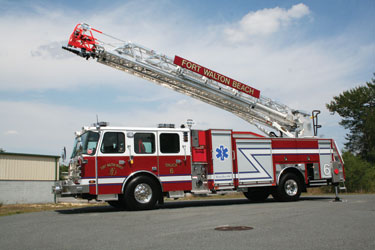 |
| (1) Fort Walton Beach (FL) Fire Department chose an E-ONE HP 78 eMAX aerial ladder for a number of reasons, but especially for the added compartmentation on the vehicle. (Photos courtesy of E-ONE.) |
Bob Wray, the sales representative for Sunbelt Fire, which sold the eMAX to Fort Walton Beach, said the truck committee had its act together in determining which bid to choose.
“I give a lot of credit to the chief’s committee that did all the research,” Wray says. “They took [the proposals] and used a scorecard to go through each of them to determine if the proposals met the specs.”
Wray notes that the eMAX concept compacts the pump module and pump panel, which allows for a shorter wheelbase on vehicles. But, it’s difficult to shorten the wheelbase on an aerial because you wouldn’t want too much ladder overhanging the vehicle. So instead, the Fort Walton Beach eMAX aerial got additional compartment space on it.
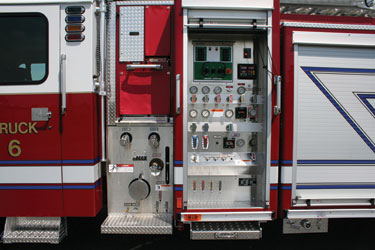 |
| (2) E-ONE’s eMAX concept compacts the pump module and pump panel to 30 inches wide, compared to 45 to 48 inches wide in a typical pump and panel layout. |
Increased Compartmentation
Blair Schrock, E-ONE’s strategic business development manager, says the eMAX’s repackaging of the pump and its control panel takes a typical 45- to 48-inch-wide pump panel and reduces it to 30 inches wide. “The eMAX also allows for lower crosslays, and the pump panel is in an enclosed compartment, isolated from the elements,” Schrock adds. He notes that E-ONE has seen more departments merging two and three types of vehicles into one-in this case an aerial, pumper, and rescue. “With their eMAX aerial, Fort Walton Beach has the added compartmentation to carry extrication and rescue equipment, even hazardous materials gear, as well as functioning as a pumper and aerial,” he says.
Wray notes that by using the long cab version instead of the medium length cab, Fort Walton Beach added another 10 inches of cab space to the vehicle in addition to picking up the added compartmentation created by the eMAX concept.
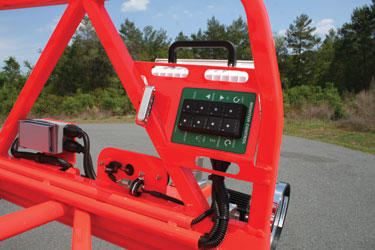 |
| (3) The monitor control panel at the tip of the aerial ladder is located on the aft side of a 750-watt quartz light. |
Perkins says that the extra compartmentation on the vehicle was well received by the truck committee, including internal roll-up door compartments on the outboard back wall of the cab’s interior. “We also liked the fact they added the 750-watt 12-volt quartz lights at the tip of the ladder, as well as the lighted ladder rungs when the ladder is extended,” he says.
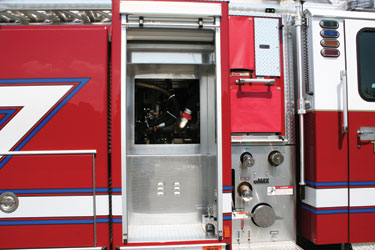 |
| (4) The smaller amount of real estate used by the aerial’s pump and controls allows the crosslays to be located lower on the vehicle. |
Engine and Truck Features
Other elements that the department requested on the vehicle were two 1¾-inch crosslays on the vehicle’s side carrying 100 feet of hose each, one 2½-inch crosslay of 75 feet in a tray in the front bumper, and a 2½-inch front discharge connected to a Task Force Tips (TFT) Blitzfire monitor.
Chris Wade, E-ONE’s regional director of the Mid-Atlantic, notes that the 75-foot aerial ladder range is the most popular category of aerial ladders at E-ONE. “The HP 78 that Fort Walton Beach bought has a 750-pound tip load, compared to our HP 75 with a 500-pound tip load, which provides a better technical rescue capability, along with the aerial ladder use and water tower capacity,” Wade points out. “Our goal was to help Fort Walton Beach put as much punch in the apparatus as possible.”
Perkins says the E-ONE eMAX has performed well since the department took delivery earlier this year. “Three weeks ago, the aerial was first due on a house fire in a single-story home,” he says, “and serving in the pumper role, the crew was able to make two saves from the house.”
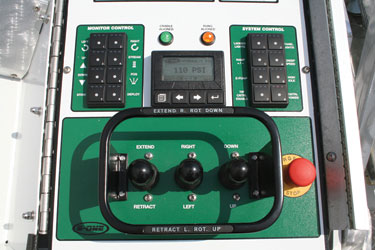 |
| (5) The aerial control panel on the new ladder is laid out for ease of operation. |
ALAN M. PETRILLO is a Tucson, Arizona-based freelance writer and is a member of the Fire Apparatus & Emergency Equipment editorial advisory board. He served 22 years with the Verdoy (NY) Fire Department, including in the position of chief.
Fort Walton Beach (FL) Fire Department
Strength: 33 paid firefighters, four other personnel, two stations.
Service area: Provides fire suppression, rescue, fire prevention/fire inspection and advanced life support medical services to the nine-square-mile city of Fort Walton Beach, population of 19,000. Coverage area is mostly residential with some commercial areas and industrial parks. Department is on automatic mutual aid to eight surrounding stations and mutual aid to all fire departments in Okaloosa, Santa Rosa, and Walton counties including military bases. The department responds to more than 3,300 calls for service a year.
Other apparatus: 2004 E-ONE pumper, 1,500-gpm pump, 500-gallon water tank, 40-gallon foam cell; GMC medium rescue truck; battalion chief’s vehicle; advanced life support ambulance. In reserve: 1996 Pierce 75-foot aerial ladder, 1,500-gpm pump, 300-gallon water tank; 1992 Pierce pumper, 1,500-gpm pump, 500-gallon water tank. Department’s Station 6 houses the Okaloosa County Special Operations Unit and also the Florida Urban Search and Rescue (FUSAR) truck.
E-ONE eMAX HP 78 Aerial
• eMAX HP 78 aerial ladder
• Typhoon long cab seating six with severe duty dash package and engine cover
• All aluminum body
• 230-inch wheelbase
• 37-foot, 11-inch overall length
• 11-foot, one-inch overall height
• Cummins ISL 450-hp diesel engine
• Allison EVS 3000 transmission
• eMAX 1,500-gpm pump built by Darley
• 500-gallon water tank
• 40-gallon foam cell with Akron in-line foam eductor
• Smart Power 10-kW generator
• Two Magnifier 750-watt, 12-volt quartz lights on ladder tip
• Two Magnifier 750-watt, 12-volt quartz lights on vehicle brow
• Two Magnifier 750-watt, 12-volt quartz lights, one each at back of cab, driver’s and officer’s sides
• Safety Vision backup camera
• Ramco busy-style remote control mirrors
• FireCom wireless intercom package
• Electric cord reel with 200 feet of cable
• Whelen LED warning light package
• Electronic and Federal Q2B mechanical sirens
Price without equipment: $625,000.

